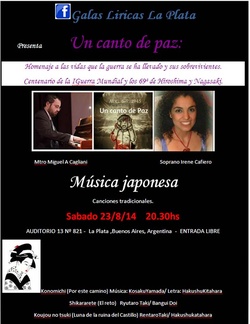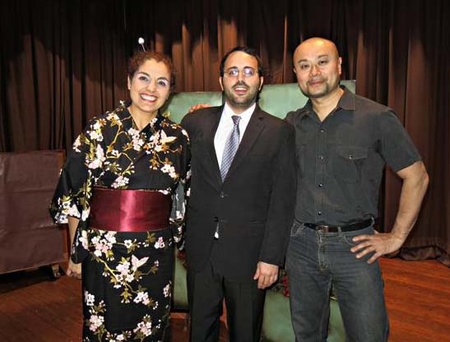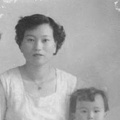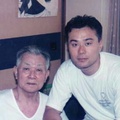On August 23, in the Auditorium of the Bar Association of the city of La Plata, a special concert was offered within the framework of the events that took place around the world, to honor the victims and survivors, due to the bombs dropped on Hiroshima and Nagasaki 1 .
In this context, the cycle of lyrical galas of our city and the Pro Onna Foundation, coordinated by María Casanovas 2 , organized “A song of Peace”, where the soprano Irene Isabel Cafiero 3 together with the pianist Miguel Ángel Cagliani 4 , performed songs traditional Japanese, but before starting them and reciting the lyrics of the poems, a report was read on the recognitions carried out in these cities.
On August 6 of this year, thousands of people gathered in Hiroshima to mark the 69th anniversary of the launching of the first atomic bomb in history, which devastated that city in western Japan.
Some survivors, relatives of victims, government officials and foreign delegations, remained motionless at 8:15 a.m., when a bell rang giving the signal to observe a minute of silence.
At that same time, on August 6, 1945, the American bomber "Enola Gay" dropped the bomb (baptized "Little Boy") that transformed the city into a nuclear hell.
Around the Peace Memorial in Hiroshima 5 , and not far from the "Genbaku Dome", an emblematic ruin of the cataclysm, numerous people have come to pray and place flowers.
About 140,000 people died in Hiroshima and about 70,000 in Nagasaki immediately or, due to radiation exposure, between the time of the bombs' impact and the month of December.
These two attacks precipitated Japan's capitulation and the end of World War II on August 15, 1945.
Next, prior to each song, the poem referring to each of them was recited, whose poets belonged to the pre-war period, but the music was composed after the Second World War. The contradictory thing is that they refer to memories, feelings of nostalgia, of loss, while the melodies are of hope.
The program consisted of the following topics:
Japanese music
Traditional songs.
- Kono michi (This way): Music: Kosaku Yamada/ Lyrics: Hakushu Kitahara
{As he walks he observes the acacia flowers, the white clock tower, the car he was driving with his mother, the branches of the rose bush and it reminds him of when he did it with his mother.} - Shikararete (The Challenge): Ryutaro Hitota/ Katsura Shimizu
{It tells the sad story of children who have to work away from their parents.} - Koujou no tsuki (Moon of the Castle Ruin): Rentaro Taki / Bansui Doi
{Memories of lights from a distant time, when everything flourished in the Castle and now the Moon only illuminates its ruins.} - Sunahama (Médano): Kosaku Yamada/ Hakushu Kitahara
{At twilight, the children return to their homes and in the sea they see the Island of Sado.} - Katyusha : Shinpei Nakayama/ Gyofu Soma and Hogetsu Shimamura
{Sings the loving feeling of a young man who says goodbye to his beloved, before leaving for the battlefield.} - Akatonbo (Red Dragonfly): Kosaku Yamada / Rofu Miki
{Contemplating a sunset, a red dragonfly perches on a branch, the author remembers his childhood and his sister about whom he receives no news.} - Sakura, Traditional Version by Michael Neam
{Cherry blossom, covering mountains and towns with its bloom. Its aroma crosses the spring sky that is carried by the wind.}
With the last topic the reflection was left: that being the cherry blossom, a symbol of life that is renewed, "Japan was renewed despite so many losses during the wars" 6 .
At the end of the Concert, the protagonists of the tribute: Irene Cafiero and Miguel Cagliani, approached the attendees to listen to their comments, which we transcribe below:
Antonio Tsuru, as a representative of the Japanese community of Colonia Urquiza and as an authority of the Japanese School, in addition to congratulating the organization said:
“It was a very exciting moment because I remembered my maternal grandfather, Tsutomu Takeuchi (1922-2009), who was in Hiroshima collaborating after the war (not in the radiation epicenter), as a radiologist, and receiving radiation since before They protected (it wasn't because of the bombs) and their war stories came to mind. Also, since my father was from Yanagawa, Fukuoka Prefecture, my close friendship with the poet Kitahara Hakushu (poet and writer of songs for children, from the Meiji Era, author of the first two songs that were performed in Japan) came to mind. the Gala) with my great-grandfather Keizo.”
This revelation led me to investigate the poet's biography and to do so I interviewed Hiroshi Tsuru (1942), Antonio's father and current President of Kyoren. He told me the family history and the connection with this important writer.
“Keizo (1885-?) was the first teacher according to the teacher regulations in those years, reaching the age of 32, to be elected director of the local school, later referring him to other educational establishments in the area. He studied at Shihaan Gakkou. When he was at Yanagawa school, he met the great poet Kitahara Hakushu (1/25/1885-11/2/1942) who came from a family of sake makers, who collapsed due to the crisis and escaped to Tokyo. This poet wrote for both adults and children, there are many songs from the Second War period that have his lyrics, and that are still sung today.
Keizo and two friends wanted to pay tribute to the poet, who was already recognized throughout the island, inviting him to Yanagawa on several occasions, but he did not accept due to the situation his family had gone through and he felt that they were at fault because they had escaped. A large collection was made among neighbors to raise money to buy his house and transform it into a museum, and invite him to the inauguration.”
Hiroshi says that his sister Michiko donated three photos from her family album to the museum, where the poet is seen walking with grandfather Keizo, who at that time was the school's director, walking through the halls of the establishment.
In short, there are always experiences to rescue, it is necessary to be attentive and know how to listen to discover that the puzzle of the life stories of many immigrants can continue to be built day after day.
Grades:
1. Among the attendees were members of the Japanese Community of Colonia Urquiza of the La Plata Party, who were specially invited, it is worth mentioning the presence of the President of the Japanese School, Nihongo Gakkou La Plata, Mr. Antonio Tsuru.
2. Lyrical Galas is a cycle of opera and film arias that has been developed periodically at the Bar Association of the city of La Plata for 6 years, with the purpose of disseminating and promoting lyrical singing in the City. General Coordinator: Andrea Casanovas; Preparatory Teacher: Soprano Linda Figueras; Pianists: Paula Gelpi and Miguel Angel Cagliani, Photography: "Contraluz" photographic art group made up of Gabriel Parentella and Liliana Ascuénaga. More info: Facebook @galas liricas la plata; google #galas lyricas la plata; youtube www.youtube.com/watch?v=pHuosZO_xS4
3. Irene Isabel Cafiero: Born in La Plata. Graduated as a Professor and Graduate of History from the National University of La Plata. Researcher from the Japanese community of La Plata.
His musical knowledge: he studied classical harp and singing at the Gilardo Gilardi Conservatory of Music in the city of La Plata. He was a member of several choirs in the city, currently the Vocal de Cámara Platense, Polifónico de La Catedral and Musiké…
Her singing and repertoire teachers were: María Gondell, Mirta Garbarini, Eduardo Cittanti, Mónica Capra, Alejandra Malvino, Guillermo Opitz, Amanda Aliana, Eduviges Picone, Mónica Quarto, Elsa Paladino among others. She has been awarded a scholarship to carry out Singing courses in: Bomarzo, Viterbo and Verona, in Italy (1999 and 2000). He has performed lyrical-chamber concerts in La Plata, in the Federal Capital, in various locations in the Province of Buenos Aires. In December 2007, in May 2009 and in November 2010, she was invited by Maestro Paula Gallardo to sing Sacred Concerts and Argentine songs in Rome (Italy). In 2010 he participated in the opening of events: in Encarnación (Paraguay), Sao Paulo (Brazil), Caracas (Venezuela). He was part of the group of singers of the Florencio Várela, Berisso and San Isidro School Orchestra Project, for the performance of Operas. He presented, along with other musicians, Patagonian songs as part of the tributes to the Native Peoples in La Plata and was part of a show by the Patricia Sosa Foundation for the Toba Community. He has been part of a theater group for three years, bringing Canciones para Mirar and Doña Disparate and Bambuco by M. E Walsh to the stage.
4. Miguel Ángel Cagliani: He was born in 1982. He graduated from the Gilardo Gilardi Conservatory of Music as a Higher Piano Professor and from the Higher Institute of Art of the Teatro Colón as Musical Director of Opera.
At the aforementioned Conservatory his teachers were: Luz María Suarez Pepe in Piano and Rubén Flores García in Chamber Music. At the same time, since 2001, she has taken private classes with Teacher Elsa Carranza.
He has had various performances, including at the Gilardo Gilardi Conservatory, with the Symphonic Group of the Police of the Province of Buenos Aires, where he was a guest soloist, performing with it at the Bar Association, Martín Fierro Theater and Teatro Coliseo Podesta. He also performed with the Choir of the British Argentine Cultural Institute and with Cantoría Ars Nova, both directed by Fernando Tomé. He also performed in places such as the National Museum of Fine Arts, the Golden Hall of the Municipality of La Plata, the Spanish Theater of Pigüé, the City Bell Chamber Theater and the Pasaje Dardo Rocha Auditorium. With the Cantoría Ars Nova he participated in the Llao Llao Musical Week that took place in the city of Bariloche. In the aforementioned auditorium of Pasaje Dardo Rocha participated in the Young Performers Cycle, organized by the Dr. Emilio Azzarini Museum of Musical Instruments of the UNLP, he has attended courses such as the V Course on Musical Interpretation for Chamber Groups and Soloists taught by maestro Jordi Mora and the II City Bell Chamber Music Course 2004 taught by maestro José Bondar.
In 2004 he won first prize in the First Internal Piano, Singing and Guitar Competition, which was held at the Gilardo Gilardi Conservatory, which is why he obtained a scholarship to pursue a Master's Degree in Piano at the Giuseppe Verdi Conservatory in Turin, Italy. , by Professor Oscar Alessi.
She also participated in the work Canciones para Mirar by Maria Elena Walsh, at the 2013 Maracaibo International Festival and with the harpist Tiziana Todoroff at the VIII International Harp Festival that took place in Rio de Janeiro.
He currently works as a teacher at the La Plata Conservatory of Music, Director of the Initiation to Choral Singing of the Argentine Theater of La Plata and pianist of the Children's Choir.
5. Other monuments later erected in the Hiroshima Peace Memorial Park, next to the Genbaku Dome, which today serves as a symbol of nuclear devastation and hope for peace, are:
Statue of the Children of the Atomic Bomb , in memory of the children who died as victims of the bomb.
Atomic Bomb Memorial Mount , with the ashes of 70 thousand unidentified victims.
Cenotaph of the Korean Victims , in tribute to the nearly 20 thousand Koreans killed in the bombing.
Commemorative Cenotaph , with the inscription "Rest in peace, for the mistake will never be repeated."
Flame of Peace , which will remain illuminating until the threat of nuclear annihilation leaves planet Earth.
Peace Bell , which visitors can ring in honor of world peace.
Hiroshima National Peace Memorial Hall , which includes the Hall of Memory with a 360º reconstruction of Hiroshima after the bomb, made up of 140 thousand bricks (the number of victims until the end of 1945).
Hiroshima Peace Memorial Museum .
Gates of Peace , five gates five meters high with the word "peace" written in several languages.
6. Information that was published in the Diario Hoy of the city of La Plata, on August 23, 2014. Year XXI, No. 7330. Page 11.
© 2014 Irene Isabel Cafiero









